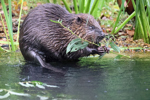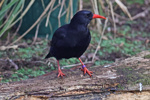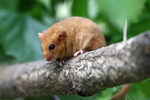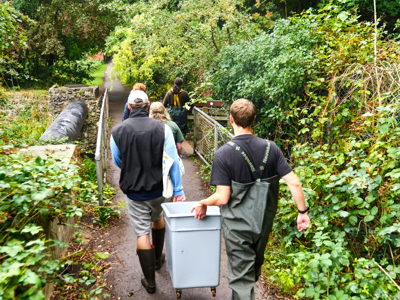
A dive behind July 2025 historic water vole release in Surrey
30th Jul 2025
On July 30th, Wildwood’s Conservation Team took part in a historic rewilding project in Surrey, releasing 50 water voles bred at Wildwood Kent to the Upper Hogsmill River and Chamber Meads wetland in Epsom and Ewell. The return of this important native rodent to the area for the first time in almost 20 years was the result of a wetland restoration project by the South East Rivers Trust (SERT) and a reintroduction project by rewilding organisation Citizen Zoo, supported by Wildwood Trust, Natural England Species Recovery Programme, Thames Water and Epsom & Ewell Borough Council.
The released water voles were from our expert captive breeding programme at Wildwood Kent. As one of the UK’s leading centres for conservation breeding, we’ve been at the forefront of water vole conservation and breeding nationwide for over 20 years. We’ve now released around 2000 water voles across the UK, playing a key role in restoring water vole populations and improving biodiversity.
Years of work have also gone into restoring the Hogsmill river and creating a new wetland habitat that is ideal for water voles. Now our water voles will be the first water voles living in the wild in Surrey for almost two decades!
The restoration of rivers and wetlands is crucial to water voles, because habitat loss, along with invasive predators, pollution and the urbanisation of rivers, have made this much-loved creature, immortalised as Ratty in The Wind in the Willows, one of the UK’s fastest-declining mammals.
It’s estimated they may have disappeared from more than 90% of their former habitats, so the return of this endangered species is a major milestone for Surrey’s biodiversity and an exciting and important rewilding project that we’re proud to support. And nothing was left to chance: although the American mink, the water vole’s main predator, had not been seen in the area for years, there was ongoing surveillance for 18 months prior to the release, with happily no sightings.
It’s the little things that matter
The UK’s biodiversity is facing a critical decline, putting our ecosystems, food security and climate resilience at risk. By returning nature to the places it once thrived, we can start to reverse that decline. Busy, burrowing water voles eat all kinds of vegetation along the riverbank, dispersing seeds by dragging flowerheads around. They’re also prolific breeders and a keystone in waterways as an integral part of the food chain.
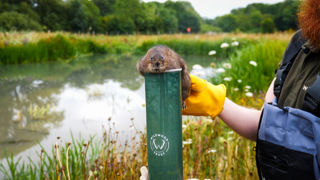
Handled with care
The water voles were transported in our special transport cages, with plenty of space for nesting material and food. They were released into aluminium “soft release” pens, packed with straw and food, which are dug into the ground but have an open base, allowing them to burrow into the ground and, importantly, return for shelter and food.
Food will continue to be provided in the pens for a couple of weeks, as they are weaned onto the wild vegetation in their new habitat.
Staff and volunteers from Citizen Zoo, which delivered a previous successful water vole release along the Hogsmill in Kingston, will monitor the population using camera traps and remote rafts, giving us regular updates. Once settled in their new habitat, we hope our released water voles will be breeding by the end of the year.
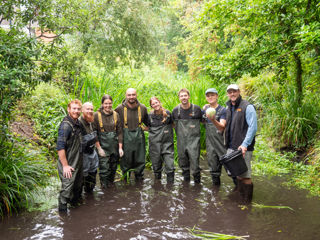
Shout-out to the Wildwood Conservation team
This is a flagship moment for urban river restoration and water vole conservation across the UK, the result of a huge amount of work by all partners in the project.
A special shout-out goes to our amazing team of Conservation Officer Tyrone Capel and Conservation Keepers Daisy and Tom, whose behind-the-scenes daily feeding, husbandry, care and breeding of the water voles released in Surrey has been absolutely essential to the success of this project.
And the work goes on… More releases are planned as we work with partners to bring Wildwood’s expertise to nature and wildlife conservation across the UK!


